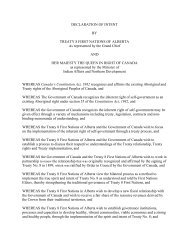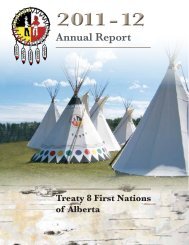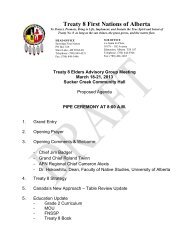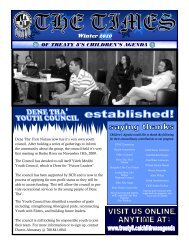Get the 2012-2013 report - Treaty 8 First Nations of Alberta
Get the 2012-2013 report - Treaty 8 First Nations of Alberta
Get the 2012-2013 report - Treaty 8 First Nations of Alberta
You also want an ePaper? Increase the reach of your titles
YUMPU automatically turns print PDFs into web optimized ePapers that Google loves.
1867<br />
The British North American<br />
Act<br />
1870<br />
Hudson Bay Company sold<br />
(?) <strong>of</strong> Rupert’s Land and<br />
North-Western Territory to<br />
<strong>the</strong> Government <strong>of</strong> Canada.<br />
1872<br />
Canadian Indian Residential<br />
Schools (<strong>the</strong> bible and <strong>the</strong><br />
plough)<br />
Canada and <strong>the</strong> <strong>First</strong> <strong>Nations</strong> Historical Timeline<br />
University <strong>of</strong> <strong>Alberta</strong><br />
In <strong>2012</strong>, <strong>Treaty</strong> 8 Livelihood department, Education Policy Studies <strong>of</strong> University <strong>of</strong> <strong>Alberta</strong>, and Keepers <strong>of</strong><br />
Athabasca agreed to do collaborative work. On October 11 - 12, <strong>2012</strong> a water symposium was held at Lister<br />
Centre, University <strong>of</strong> <strong>Alberta</strong> campus. Ano<strong>the</strong>r water conference took place on May 2nd, <strong>2013</strong> at <strong>the</strong> Edmonton<br />
Health Clinic, University <strong>of</strong> <strong>Alberta</strong> campus.<br />
CBFA<br />
Canadian Boreal Forest Agreement - The CBFA is collaboration between 21 major Canadian Forest product<br />
companies and 9 leading environmental organizations. It applies to more than 72 million hectares <strong>of</strong> boreal forest<br />
from Newfoundland to British Columbia coast. The CBFA is a 3-year agreement, with provisions for extension<br />
(started in 2010) under which forestry signatories “commit to <strong>the</strong> highest environmental standards <strong>of</strong> forestry<br />
management and conservation” and environmental organizations commit to Global recognition and support for<br />
Forest Products Association <strong>of</strong> Canada (FPAC) member efforts. The participating companies and environmental<br />
organizations believe that forest conservation and business competitiveness requires fair, inclusive involvement<br />
<strong>of</strong> <strong>First</strong> <strong>Nations</strong> governments within <strong>the</strong> CBFA process. A group has been formed to work on issues related<br />
to <strong>the</strong> <strong>Alberta</strong>/BC landscape. This group, called <strong>the</strong> <strong>Alberta</strong>/BC Regional Working Group (RWG) is focusing<br />
on Nor<strong>the</strong>astern <strong>Alberta</strong> as an initial priority area for Caribou Action Planning. <strong>Treaty</strong> 8 has met with CBFA<br />
technicians for information ga<strong>the</strong>ring and dispensing. As stated before, Consultation on forestry related issues<br />
would rest with <strong>First</strong> <strong>Nations</strong>.<br />
Jasper Park<br />
Healing and Reconciliation: The Jasper Aboriginal Forum<br />
In 1907, when Jasper National Park was established,<br />
<strong>the</strong>re were several hundred indigenous people living in<br />
<strong>the</strong> park. Park legislation and management, based on<br />
European ideas <strong>of</strong> Conservation and Tourism, did not<br />
consider Indigenous perspectives and traditions, and way<br />
<strong>of</strong> life. Early park managers considered many traditional<br />
activities, like hunting, ga<strong>the</strong>ring and burning, at best<br />
inconsistent with National Park goals and, at worst,<br />
unlawful.<br />
<strong>First</strong> <strong>Nations</strong> and Metis people who considered <strong>the</strong> area<br />
part <strong>of</strong> <strong>the</strong>ir territory included: Cree, Stoney, Shuswap,<br />
Iroquois, Ojibwa, and o<strong>the</strong>r <strong>First</strong> <strong>Nations</strong> and metis were<br />
forcibly removed from <strong>the</strong> park. Parks Canada is now<br />
attempting to mend broken relationships with <strong>First</strong> <strong>Nations</strong> and Metis. For instance, Parks Canada’s approach<br />
to protected areas management is to include <strong>the</strong> <strong>First</strong> <strong>Nations</strong> people whose Traditional Territories are involved<br />
within <strong>the</strong> Jasper National park. Parks Canada is planning to construct a <strong>First</strong> <strong>Nations</strong> and Metis site in <strong>the</strong> town<br />
<strong>of</strong> Jasper that will have a symbolic meaning in <strong>the</strong> form <strong>of</strong> a carving, artwork or monument that communicates<br />
<strong>First</strong> <strong>Nations</strong> and Metis presence in <strong>the</strong> park. Fur<strong>the</strong>rmore, Parks Canada is to set aside an area where <strong>First</strong><br />
<strong>Nations</strong> and Metis are able to continue ceremonial practices, and traditional dances as before.<br />
Page 18















